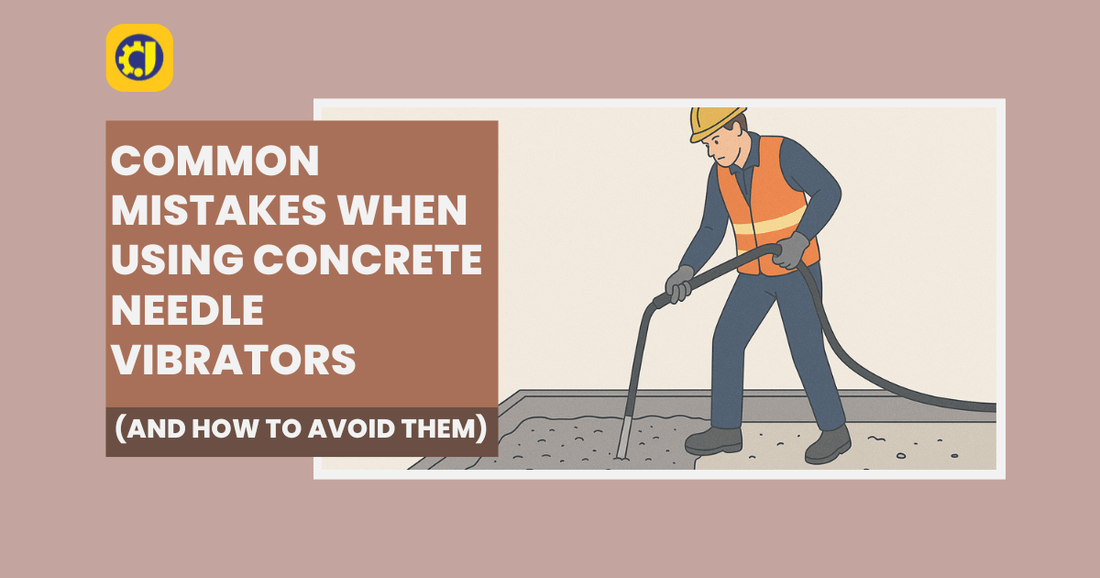
Common Mistakes When Using Concrete Needle Vibrators (and How to Avoid Them)
Using a concrete needle vibrator is essential for achieving high-quality concrete compaction. However, even experienced workers sometimes make avoidable errors that can lead to poor results, equipment damage, or safety risks.
In this post, we’ll explore the most common mistakes and show you how to avoid them for better performance and longer equipment life.
Why Avoiding Mistakes Matters
Although the concrete needle vibrator is a powerful tool, improper usage can weaken the final structure. Moreover, small errors often lead to expensive fixes, delays, and even unsafe work conditions.
Top Mistakes and How to Avoid Them
1. Using the Wrong Size Vibrator
Not all jobs require the same vibrator head size. Using one that’s too large or too small can cause uneven compaction or slower work.
How to Avoid It
First, match the vibrator size to your project. For narrow columns, use smaller heads. For slabs, larger heads are better. Always choose based on the area and concrete thickness.
2. Leaving the Vibrator in Too Long
Keeping the vibrator in one spot for too long can cause over-vibration. As a result, it leads to segregation where aggregates sink and water rises.
How to Avoid It
Generally, 5 to 15 seconds per insertion is enough. Move the vibrator steadily and vertically. In addition, always watch the concrete surface for signs of settling.
3. Removing the Vibrator Too Quickly
On the flip side, pulling out the vibrator too fast can create voids or air pockets, reducing concrete strength.
How to Avoid It
Withdraw the vibrator slowly, about 3 cm per second. This allows the space left behind to be filled smoothly without trapping air.
4. Vibrating in Large Layers
Thick concrete layers may seem quicker to pour and vibrate. However, this often leaves the lower part under-compacted.
How to Avoid It
Keep each pour layer around 12 to 18 inches deep. Overlap vibrator insertions between layers to ensure full bonding and uniform compaction.
5. Not Following a Vibration Pattern
Random vibrating leads to missed spots or unnecessary overlap. Consequently, this can result in weak zones or wasted effort.
How to Avoid It
Plan a consistent grid pattern before starting. Insert the vibrator at equal distances—usually about 1.5 times the vibrator head diameter apart.
6. Not Checking the Concrete Consistency
Some users vibrate dry or stiff concrete excessively, hoping it will flow better. This does more harm than good.
How to Avoid It
Before vibrating, test the concrete slump. If it’s too stiff, adjust the mix rather than over-vibrating. Remember, the vibrator is for compaction, not flow correction.
7. Using a Damaged Needle or Shaft
Worn or bent needles reduce efficiency and may damage the motor. Plus, they can result in uneven compaction.
How to Avoid It
Inspect the needle and shaft before each use. If you notice dents, cracks, or unusual vibrations, repair or replace the parts immediately.
8. Skipping Maintenance
Even if your equipment seems fine, skipping routine checks shortens its lifespan. Furthermore, it increases the risk of breakdowns during critical jobs.
How to Avoid It
Clean your concrete needle vibrator after every use. Lubricate moving parts weekly and check all electrical connections. Also, store it in a dry place away from moisture and dust.
9. Not Wearing Safety Gear
Some workers skip protective gear, especially during short tasks. Unfortunately, this increases the risk of injury, especially around wet concrete and electric tools.
How to Avoid It
Always wear gloves, boots, safety glasses, and ear protection. Also, make sure cords and plugs are free from moisture before connecting the vibrator.
10. Untrained Operators
Unskilled workers often mishandle the equipment. They may use it incorrectly, which not only damages the tool but also affects the final concrete finish.
How to Avoid It
Train every operator on proper usage. Make sure they understand vibration time, insertion depth, and safety checks. Even a 15-minute demo can make a big difference.
Pro Tips for Best Results
Use the Right Power Source
Fluctuating voltage can harm your concrete needle vibrator. So, always check the power supply and use recommended extension cords.
Monitor Noise and Heat
Louder than normal operation or excess heat may signal internal issues. Therefore, stop and inspect immediately to prevent serious damage.
Conclusion
Avoiding common mistakes while using a concrete needle vibrator is the key to safe, efficient, and high-quality concrete work. While the tool itself is simple to operate, success depends on careful planning, proper technique, and regular maintenance.
By staying aware of these pitfalls and using the tips above, you’ll not only save time and money but also ensure stronger, more durable concrete results.